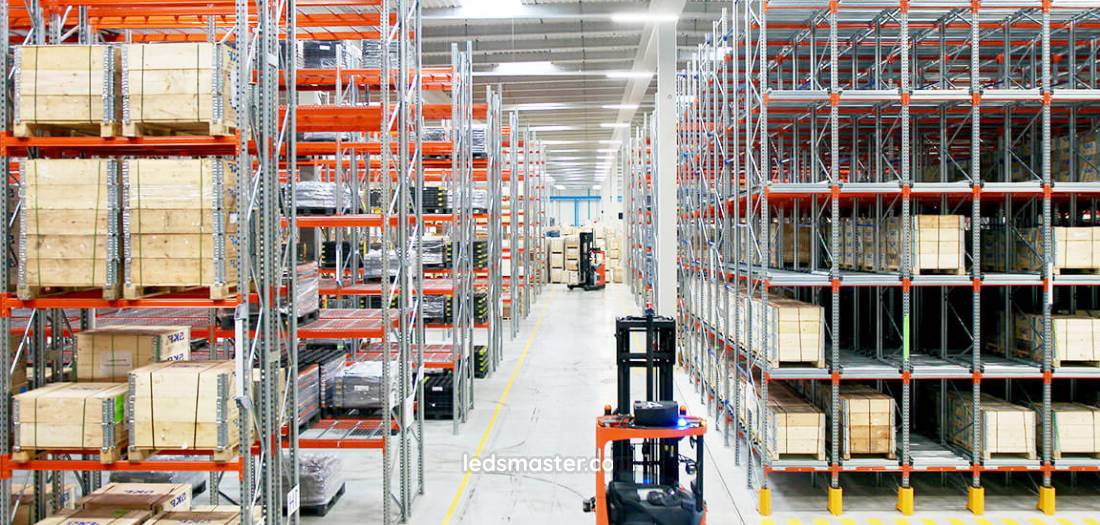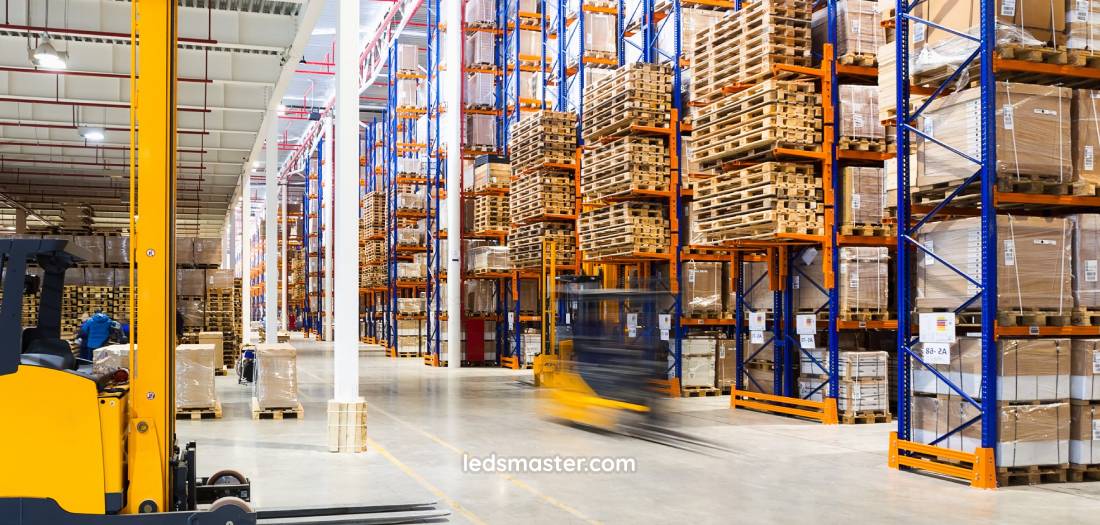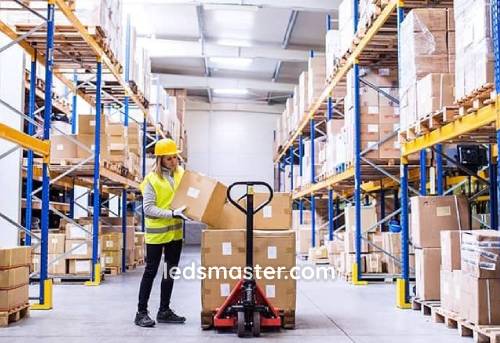Warehouse lighting goes beyond simply illuminating a space. It directly influences how efficiently workers perform tasks, how safely equipment is operated, and how products are stored and retrieved. The unit of measurement most commonly used to evaluate lighting intensity in a space is the lux. One lux is equal to one lumen per square meter. Knowing how lux functions in the context of warehouse lighting can shape a design that matches the actual activities performed in each area.
| Warehouse Zone | Recommended Lux Range | Purpose/Usage |
|---|---|---|
| Bulk Storage Areas | 100–150 lux | Basic navigation, safety, and visibility for areas with minimal human interaction |
| Picking and Sorting Zones | 200–300 lux | Task-specific work such as selecting, labeling, and preparing items |
| Loading Docks and Shipping Areas | 200–300 lux | Safe handling of materials and machinery operation, accounting for fluctuating daylight |
| Inspection and Quality Control Zones | 400–600 lux | Detailed visual checks, product assessments, quality control tasks |
| Offices and Administrative Sections | 300–500 lux | Office work, computer use, paperwork, and meetings |
Table of Contents
ToggleWhat Is Lux and Why It Matters in a Warehouse Environment
Lux measures the amount of visible light that hits a surface. It differs from lumens, which refer to the total quantity of visible light emitted by a source. While lumens help determine how powerful a light fixture is, lux tells you how much of that light effectively reaches a given surface area. In warehouse settings, this distinction is fundamental because different zones have varying lighting demands. The lux level needed for general movement through aisles is not the same as that needed for reading labels, inspecting goods, or operating machinery.
Lighting Standards and Regulatory Guidelines

Lighting guidelines for warehouses are typically outlined by national and international organizations such as the International Organization for Standardization (ISO), the Chartered Institution of Building Services Engineers (CIBSE), and regional occupational health and safety authorities. These frameworks provide recommendations that align lighting levels with the nature of activities conducted in various zones within a warehouse. The classification is based on how demanding the visual tasks are, the time spent in the space, and potential risks associated with poor visibility.
For example, areas primarily used for storage and minimal human interaction are generally assigned lower lux thresholds, often in the range of 100 to 150 lux. In contrast, spaces where workers are engaged in active tasks such as packing, sorting, or handling documentation may require lighting levels of 200 to 300 lux to ensure items are clearly identifiable and operational errors are minimized. Inspection areas, where detailed visual checks or quality assurance processes take place, may call for lux levels reaching 500 or higher, as these tasks rely on a greater degree of precision and visual focus.
These recommended ranges aim to create an environment where visibility aligns with the work being carried out, supporting task performance without creating excessive brightness that leads to visual discomfort or wasted energy. Well-applied standards also take into account uniformity, glare control, and color rendering to help ensure that lighting contributes to an overall workspace that is consistent, functional, and responsive to operational needs.
Factors That Influence Lux Requirements in Warehouses

Type of Activities Performed
The nature of work performed in a warehouse greatly influences the lighting design. For instance, warehouses that only store pallets on racks may not need as much illumination as those that involve order picking, sorting, or quality control. When visual accuracy is involved, such as reading serial numbers or checking labels, lux requirements increase substantially. Recognizing the types of tasks being carried out helps ensure each zone receives adequate lighting coverage.
Ceiling Height and Fixture Placement
Most warehouses have high ceilings, which introduces a challenge in delivering the appropriate amount of light to the floor or working plane. The higher the light source, the more the intensity decreases before reaching the surface. Lighting designers must factor in the mounting height and angle of each fixture to maintain effective lux levels. High bay lighting solutions are often employed in such settings to overcome these height challenges and provide uniform coverage.
Color and Reflectivity of Surfaces
The materials and colors within a warehouse affect how light behaves. Lighter-colored walls and floors reflect more light, which can improve perceived brightness and reduce the number of fixtures needed. In contrast, dark surfaces absorb more light, requiring a higher output from luminaires to achieve the same lux levels. Assessing the surface reflectivity helps fine-tune calculations for fixture placement and power.
Natural Daylight Availability
Some warehouses are equipped with skylights or large windows, allowing daylight to contribute to overall lighting levels. This natural light can supplement artificial lighting and help maintain consistent lux levels during daytime operations. However, designers must ensure that changes in daylight throughout the day or in different seasons do not create shadows or glare that impair visibility.
Lighting Zones and Their Lux Requirements
Bulk Storage Areas
Bulk storage areas are typically designed for the storage of goods in large quantities, often stacked on racks or pallets. These areas generally do not involve regular human interaction or detailed visual tasks, as the goods are primarily stored for long periods. The lighting needs in these zones are therefore relatively modest. A minimum lux level of around 100 is often sufficient to ensure basic visibility for navigation and safety. The goal is to provide enough light to avoid accidents when moving through aisles or around stacks of goods. However, because these areas are less active compared to other zones, energy-efficient lighting solutions are highly recommended. For instance, motion-activated lights can be employed to ensure that the lighting is only activated when the area is in use, thus reducing energy consumption during unoccupied times. In some cases, lux levels can be lower, particularly in areas where visibility isn’t as critical, and lighting is often more functional rather than task-oriented.
Picking and Sorting Zones
 Picking and sorting areas require significantly higher lux levels, as workers spend extended periods selecting items, sorting them, labeling products, or preparing goods for shipment. These tasks often involve reading small labels, identifying product numbers, or inspecting items for quality, which requires precise lighting to avoid errors. The recommended lux level for these zones typically ranges from 200 to 300, depending on the specific tasks. This range allows for clear visual recognition and reduces the risk of strain or mistakes when handling items. The lighting should be uniform to prevent shadows or dark spots that could hinder workers’ ability to pick or sort goods efficiently. Areas where smaller products are handled may require lux levels at the higher end of this range to ensure that fine details can be clearly distinguished. Additionally, proper illumination contributes to better task execution, as it supports visual comfort and allows workers to remain focused for long periods without experiencing fatigue.
Picking and sorting areas require significantly higher lux levels, as workers spend extended periods selecting items, sorting them, labeling products, or preparing goods for shipment. These tasks often involve reading small labels, identifying product numbers, or inspecting items for quality, which requires precise lighting to avoid errors. The recommended lux level for these zones typically ranges from 200 to 300, depending on the specific tasks. This range allows for clear visual recognition and reduces the risk of strain or mistakes when handling items. The lighting should be uniform to prevent shadows or dark spots that could hinder workers’ ability to pick or sort goods efficiently. Areas where smaller products are handled may require lux levels at the higher end of this range to ensure that fine details can be clearly distinguished. Additionally, proper illumination contributes to better task execution, as it supports visual comfort and allows workers to remain focused for long periods without experiencing fatigue.
Loading Docks and Shipping Areas
Loading docks and shipping areas are high-traffic zones where materials are constantly moved, and safety is a top concern. These areas often involve the operation of forklifts or other heavy machinery, and the lighting must ensure that both workers and equipment operators can perform their tasks safely. A lux level of around 200 to 300 is generally recommended to provide clear visibility for loading and unloading activities. However, the lighting requirements can vary depending on the space’s layout and whether it is an open or enclosed dock. In open docks, daylight can fluctuate throughout the day, meaning the artificial lighting must balance with natural light to maintain consistent lux levels. In these cases, advanced lighting control systems that adjust light output based on natural light levels can help maintain the target lux range. Additionally, glare control is a crucial aspect in these areas. Reflective surfaces from the warehouse floor, vehicles, or equipment can create distracting glare, which can impair visibility and increase the risk of accidents. Therefore, it is important to design the lighting system to minimize direct glare by using fixtures with diffusers or directional lighting that targets specific areas.
Inspection and Quality Control Zones
Inspection and quality control areas are integral to ensuring that goods meet the required standards before they are shipped or stored. Tasks in these zones often require a high level of visual detail, such as checking the quality of products, reading labels, or verifying packaging. For these areas, lux levels between 400 and 600 are recommended to provide bright, uniform lighting that supports accurate visual assessments. This range is necessary to prevent errors that could arise from poor visibility, such as overlooking defects or misreading specifications. The lighting in these zones should also offer good color rendering to ensure that the true colors of the products are visible and can be properly assessed. Inadequate lighting in inspection zones can lead to undetected faults, ultimately impacting the quality of goods shipped or stored. Uniform illumination is especially important to avoid shadows that could obscure parts of products being examined. Given that workers often spend considerable time in these areas, providing consistent light without flickering or uneven brightness is critical for productivity and visual comfort.
Offices and Administrative Sections
Warehouses often have office spaces, administrative areas, or control rooms where staff perform tasks such as inventory management, order processing, or administrative work. These spaces require lighting that supports tasks such as reading documents, working on computers, or holding meetings. The lux levels for these areas generally range between 300 and 500, which aligns with standard office lighting requirements. This range is ideal for general office tasks and ensures that workers can perform their duties without straining their eyes. Lighting in these areas should be uniform, with soft, diffused light to avoid harsh contrasts that can cause discomfort. Additionally, adjustable task lighting is a practical solution for areas where individual tasks, such as reading or working at a computer, require more focused light. Good lighting design in these spaces helps to reduce eye strain and enhances worker comfort, which is particularly important given the long hours typically spent in office settings. By balancing the lux levels to match the tasks at hand, these areas can remain conducive to productivity without causing unnecessary distractions.
Choosing the Right Fixtures and Technologies
Selecting fixtures that match the warehouse layout and tasks performed plays a direct role in maintaining the desired lux levels. LED lighting has become the preferred solution due to its energy performance, durability, and ability to integrate with smart controls. High bay LED fixtures are particularly suited for expansive areas with high ceilings, offering directional light with consistent intensity. Fixtures with optical lenses or reflectors help control light distribution and minimize shadows or dark spots.
Control Systems and Automation for Lighting
Modern warehouses are increasingly integrating sophisticated lighting control systems to optimize both lighting conditions and energy usage. By leveraging technologies such as motion sensors, timers, and daylight sensors, these systems can automatically adjust light output to maintain the desired lux levels only when and where they are needed. Motion sensors are particularly effective in low-traffic or less frequently used areas, where they ensure that lighting is only activated when workers or equipment are present. Daylight sensors are used in areas with access to natural light, adjusting artificial lighting levels based on the amount of sunlight available. This dynamic adjustment helps to keep lux levels consistent without wasting energy during periods of high natural light.
Zoning Controls for Operational Efficiency
Zoning controls are another feature commonly used in warehouse lighting systems. These controls allow lighting to be adjusted independently across different zones, providing flexibility to align lighting output with operational schedules and activities. For example, the lux level in the bulk storage area can be lower than in picking or sorting zones, and these can be adjusted as needed based on the time of day or specific tasks being carried out. Zoning can also help manage energy costs by ensuring that lights are dimmed or turned off in areas where they are not required, such as during non-peak hours or when certain tasks are not in progress. The ability to tailor lighting levels in various parts of the warehouse improves both energy efficiency and overall lighting effectiveness.
Improving Comfort and Safety with Lighting Control
Lighting control systems not only contribute to energy savings but also enhance the working environment. By adjusting lux levels to match the activities performed in each area, these systems create a more comfortable atmosphere for workers. For example, areas with high activity or task-specific work, such as sorting or inspection zones, benefit from higher lux levels, while low-traffic storage areas can have dimmed lights, contributing to a more balanced and pleasant environment. Additionally, by minimizing the intensity of light in areas where it is not required, workers can avoid the discomfort that comes with overly bright spaces, which can lead to eye strain and fatigue.
Measuring and Verifying Lux Levels
Accurate measurement of lux levels is crucial to ensuring that the lighting design aligns with the specified requirements for each warehouse zone. Various methods are available for measuring lux, with handheld lux meters and automated monitoring systems being the most common tools. Handheld lux meters offer a quick and straightforward way to measure light levels at specific points in a space, while automated systems allow for continuous monitoring of light output across large areas. These systems can be integrated with the warehouse’s lighting controls to provide real-time feedback and adjustments.
Uniformity and Consistency in Lighting
When measuring lux levels, lighting designers often employ a uniform grid approach, taking measurements at regular intervals across representative areas of the warehouse. This method ensures that the lux levels are evenly distributed and that no section is either over-illuminated or under-illuminated. Uniform lighting helps prevent areas of excessive brightness or dimness, which could cause visual discomfort or hinder task performance. Maintaining a consistent light level across different sections of the warehouse is particularly important for tasks that require precision, such as in inspection zones, where uneven lighting could lead to missed defects or errors.
Audits and System Verification
Regular audits and checks are necessary to ensure that the installed lighting systems continue to meet the original design targets. Changes in warehouse layout, such as reconfiguring racking systems, can impact light distribution and necessitate adjustments to the lighting configuration. These audits help verify that lux levels remain consistent with the standards set for each zone, ensuring that lighting performance doesn’t degrade over time. Additionally, these assessments can identify areas where improvements are needed, such as enhancing uniformity or addressing energy inefficiencies. By regularly evaluating lux levels and making necessary adjustments, warehouses can maintain optimal lighting conditions while also ensuring compliance with relevant standards and regulations.
Energy Efficiency and Environmental Considerations
Warehouse lighting design also intersects with sustainability goals. By targeting lux levels that support tasks without exceeding needs, energy consumption can be reduced without compromising the working environment. LEDs offer a low power-to-output ratio, and when paired with intelligent controls, they form a robust strategy for reducing carbon footprint. Additionally, maintenance frequency is minimized with longer-life luminaires, supporting smoother facility operations over time.
Conclusion
Warehouse lighting design built around lux requirements ensures that each zone supports the tasks performed within it. From high-activity picking areas to quiet storage zones, appropriate lighting fosters safety, visual comfort, and efficiency. Decisions regarding fixture types, control systems, and layout should reflect the diversity of functions within the facility. The concept of lux provides a practical framework for achieving light levels that respond to real-world needs. By considering layout, ceiling height, surface reflectance, and daylight access, lighting plans can be tailored to suit both operational and energy performance goals.

